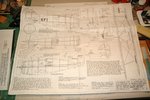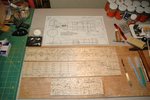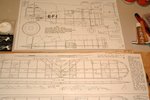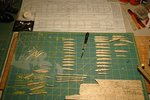ccheese
Member In Perpetuity
Username: ccheese
Name: Charles
Category: Non-Competing Judge
Kit:: Rubber powered Balsa/Tissue model of U.S.Navy Grumman F3F-2
Manufacture: Diels Engineering Co. Of Amherst, Ohio
Scale: 1/24
Accessories: None, OOB
This is going to be a very difficult build. The plans were drawn in 1997, and the construction procedures are quite old. Also, the plans are very vague when it comes to some of the more difficult construction. I intend to change the wheels to rubber, as the plans call for several round pieces of balsa sanded to look like wheels. The tail piece is also several pieces of balsa glued together and sanded. I will replace this with a balsa block, sanded to shape. The wing tips will be solid balsa, sanded to shape, also.
Most of my builds start with the fuselage, then progress to the wings, tail, etc. This one will start with the lower wing, then the fuselage, tail and upper wing.
The plans are quite big, and two sided. I have made copies of the components and will work from these.
I have several things on my plate, so it will be a few days before construction actually starts
History
In 1935 the U.S. Navy placed an order with the Grumman Aircraft Engineering Corporation, then of Farmingdale, for the design and construction of a new fighter, the F3F. Based on earlier Grumman biplane designs, the F3F was faster and more maneuverable than any Navy fighter to date. By 1937, due to the slow development of the early monoplane fighters, the Navy ordered more F3Fs, this time an improved model, the F3F-2. The F3F-2 was strong, fast, maneuverable, and was considered a wonderful aircraft to fly. Its pilots considered it the ultimate biplane fighter; in fact it was the last biplane fighter produced in the United States. With its silver fuselage, yellow wings, and red, white, and blue markings, it was among the most colorful military aircraft ever built, but it heralded the end of an era.
By 1939 all U.S. Navy and Marine fighter squadrons flew Grumman biplane fighters exclusively. Of the 164 F3Fs built, 140 were still in service, as trainers in United States, at the time of the U.S. entry into World War II in December, 1941.
Today the F3F is an extremely rare aircraft, with but two original surviving examples.
Here's a good video:
View: https://www.youtube.com/watch?v=Os19XiWGDjs
Charles
Name: Charles
Category: Non-Competing Judge
Kit:: Rubber powered Balsa/Tissue model of U.S.Navy Grumman F3F-2
Manufacture: Diels Engineering Co. Of Amherst, Ohio
Scale: 1/24
Accessories: None, OOB
This is going to be a very difficult build. The plans were drawn in 1997, and the construction procedures are quite old. Also, the plans are very vague when it comes to some of the more difficult construction. I intend to change the wheels to rubber, as the plans call for several round pieces of balsa sanded to look like wheels. The tail piece is also several pieces of balsa glued together and sanded. I will replace this with a balsa block, sanded to shape. The wing tips will be solid balsa, sanded to shape, also.
Most of my builds start with the fuselage, then progress to the wings, tail, etc. This one will start with the lower wing, then the fuselage, tail and upper wing.
The plans are quite big, and two sided. I have made copies of the components and will work from these.
I have several things on my plate, so it will be a few days before construction actually starts
History
In 1935 the U.S. Navy placed an order with the Grumman Aircraft Engineering Corporation, then of Farmingdale, for the design and construction of a new fighter, the F3F. Based on earlier Grumman biplane designs, the F3F was faster and more maneuverable than any Navy fighter to date. By 1937, due to the slow development of the early monoplane fighters, the Navy ordered more F3Fs, this time an improved model, the F3F-2. The F3F-2 was strong, fast, maneuverable, and was considered a wonderful aircraft to fly. Its pilots considered it the ultimate biplane fighter; in fact it was the last biplane fighter produced in the United States. With its silver fuselage, yellow wings, and red, white, and blue markings, it was among the most colorful military aircraft ever built, but it heralded the end of an era.
By 1939 all U.S. Navy and Marine fighter squadrons flew Grumman biplane fighters exclusively. Of the 164 F3Fs built, 140 were still in service, as trainers in United States, at the time of the U.S. entry into World War II in December, 1941.
Today the F3F is an extremely rare aircraft, with but two original surviving examples.
Here's a good video:
View: https://www.youtube.com/watch?v=Os19XiWGDjs
Charles
Attachments
Last edited:





